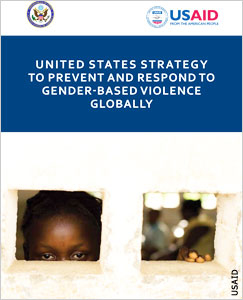U.S. Strategy Seeks End to Violence Against Women, Girls
U.S. Strategy Seeks End to Violence Against Women, Girls
13 August 2012

USAID said its operations in Washington and abroad will translate the strategy into meaningful action for millions of women, men and children worldwide
Washington — Violence against women and girls is a widespread global problem that produces grave societal consequences. The United States wants to change that.
The Obama administration on August 10 launched the “United States Strategy to Prevent and Respond to Gender-Based Violence Globally.”
The strategy outlines four key objectives: to increase coordination of gender-based violence prevention and response efforts among U.S. government agencies and with other involved parties; to enhance integration of gender-based violence prevention and response efforts into existing U.S. government work; to improve collection, analysis and use of data and research to enhance gender-based violence prevention and response efforts; and to enhance or expand programs that address gender-based violence.
The strategy document was requested by the U.S. Congress and was drafted by the U.S. Agency for International Development (USAID), the U.S. Department of State and other relevant U.S. agencies.
The strategy was launched during an August 10 event at the White House, which gathered senior administration officials and civil society representatives who have supported the administration’s work in gender-based violence prevention and, more broadly, on gender equality and women’s empowerment.
At the event, a new executive order by President Obama was presented. The executive order creates an interagency working group to be co-chaired by the secretary of state and the administrator of USAID and directs departments and agencies to implement the new strategy.
USAID said it will strive to ensure its missions abroad and operating units in Washington translate the strategy into meaningful action for millions of women, men and children worldwide.
Preventing and responding to gender-based violence is a cornerstone of the administration’s commitment to advancing gender equality.
Violence against women and girls cuts across ethnicity, race, class, religion, education level and international borders, a White House fact sheet on the strategy says. “Although statistics on the prevalence of violence vary,” the White House says, “the scale is tremendous, the scope is vast, and the consequences for individuals, families, communities and countries are devastating.
“An estimated one in three women worldwide has been beaten, coerced into sex, or otherwise abused in her lifetime. Intimate partner violence is the most common form of violence experienced by women globally. Other forms of violence include human trafficking, sexual violence, including when used as a tactic of war, and harmful traditional practices, such as early and forced marriage, female genital mutilation/cutting, and ‘honor’ killings.”
Such violence significantly hinders the ability of individuals to fully participate in and contribute to their families and communities — economically, politically and socially, USAID said on its website.
Vice President Biden, who authored the Violence Against Women Act while in the Senate, has been a leader in efforts to end violence against women and girls for two decades. Secretary of State Hillary Rodham Clinton and USAID Administrator Raj Shah have also been advocates for ending gender-based violence, and have elevated this issue as a foreign policy priority.
More information is available on the USAID website.